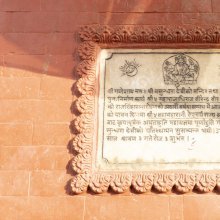Lakshmidevi, Lakṣmīdevī, Lakshmi-devi: 6 definitions
Introduction:
Lakshmidevi means something in Hinduism, Sanskrit, Jainism, Prakrit. If you want to know the exact meaning, history, etymology or English translation of this term then check out the descriptions on this page. Add your comment or reference to a book if you want to contribute to this summary article.
The Sanskrit term Lakṣmīdevī can be transliterated into English as Laksmidevi or Lakshmidevi, using the IAST transliteration scheme (?).
Images (photo gallery)
In Hinduism
Vaishnavism (Vaishava dharma)
Source: Pure Bhakti: Brhad BhagavatamrtamLakṣmīdevī (लक्ष्मीदेवी) refers to:—The eternal consort of Śrī Nārāyaṇa in Vaikuṇṭha; the consort of the Lord in all His expansions; the goddess of fortune. (cf. Glossary page from Śrī Bṛhad-bhāgavatāmṛta).

Vaishnava (वैष्णव, vaiṣṇava) or vaishnavism (vaiṣṇavism) represents a tradition of Hinduism worshipping Vishnu as the supreme Lord. Similar to the Shaktism and Shaivism traditions, Vaishnavism also developed as an individual movement, famous for its exposition of the dashavatara (‘ten avatars of Vishnu’).
In Jainism
General definition (in Jainism)
Source: Shodhganga: A cultural study on the jain western Indian illustrated manuscriptsLakṣmīdevī (लक्ष्मीदेवी).—The fourth of “fourteen dreams” of Triśalā.—Lakshmῑ Devi appeared awned, broad symmetrical shoulders and beautiful walking gait with raised curled tail manifested sitting on a lotus, whose delicate hands and feet appeared like lotus petals. She had lotus like eyes, long hair, well-filled body, water pot like pair of breasts and narrow waist, very attractive. She was decked up with ornaments and her earrings touched her cheeks. She held lotuses in both hands, while elephants were lustrating her with water.

Jainism is an Indian religion of Dharma whose doctrine revolves around harmlessness (ahimsa) towards every living being. The two major branches (Digambara and Svetambara) of Jainism stimulate self-control (or, shramana, ‘self-reliance’) and spiritual development through a path of peace for the soul to progess to the ultimate goal.
Languages of India and abroad
Sanskrit dictionary
Source: Cologne Digital Sanskrit Dictionaries: Aufrecht Catalogus CatalogorumLakṣmīdevī (लक्ष्मीदेवी) as mentioned in Aufrecht’s Catalogus Catalogorum:—C. on the Vyavahārādhyāya of Vijñāneśvara’s Mitākṣarā.
Source: Cologne Digital Sanskrit Dictionaries: Monier-Williams Sanskrit-English DictionaryLakṣmīdevī (लक्ष्मीदेवी):—[=lakṣmī-devī] [from lakṣmī-deva > lakṣmī > lakṣ] f. Name of a learned woman, [Catalogue(s)]
[Sanskrit to German]
Sanskrit, also spelled संस्कृतम् (saṃskṛtam), is an ancient language of India commonly seen as the grandmother of the Indo-European language family (even English!). Closely allied with Prakrit and Pali, Sanskrit is more exhaustive in both grammar and terms and has the most extensive collection of literature in the world, greatly surpassing its sister-languages Greek and Latin.
See also (Relevant definitions)
Partial matches: Lakshmi, Devi, Tevi.
Query error!
Full-text: Lashamadevi, Shri, Lakhimadevi, Maharani, Lakshmi, Cala, Caitanya, Rama, Gramadevata, Shrimati, Mitakshara, Radha, Uccaihshravas, Kalanirnaya, Rijumitakshara.
Relevant text
Search found 35 books and stories containing Lakshmidevi, Lakṣmīdevī, Lakshmi-devi, Lakṣmī-devī, Laksmidevi, Laksmi-devi; (plurals include: Lakshmidevis, Lakṣmīdevīs, devis, devīs, Laksmidevis). You can also click to the full overview containing English textual excerpts. Below are direct links for the most relevant articles:
Chaitanya Bhagavata (by Bhumipati Dāsa)
Verse 1.14.18 < [Chapter 14 - The Lord’s Travel to East Bengal and the Disappearance of Lakṣmīpriyā]
Verse 1.14.38-39 < [Chapter 14 - The Lord’s Travel to East Bengal and the Disappearance of Lakṣmīpriyā]
Verse 1.15.170 < [Chapter 15 - Marriage with Śrī Viṣṇupriyā]
The history of Andhra country (1000 AD - 1500 AD) (by Yashoda Devi)
Part 47 - Mangiraju (A.D. 1263 and Upendra A.D. 1263-1289) < [Chapter XIII - The Dynasties in South Kalinga]
Part 16 - Upendra I (A.D. 1266) < [Chapter XI - The Chalukyas]
Part 26 - Pratapa Gangaraju (A.D. 1319-1368) < [Chapter XIII - The Dynasties in South Kalinga]
Brihad Bhagavatamrita (commentary) (by Śrī Śrīmad Bhaktivedānta Nārāyana Gosvāmī Mahārāja)
Verse 2.1.161 < [Chapter 1 - Vairāgya (renunciation)]
Verse 1.2.41-42 < [Chapter 2 - Divya (the celestial plane)]
Verse 2.2.139 < [Chapter 2 - Jñāna (knowledge)]
Srila Gurudeva (The Supreme Treasure) (by Swami Bhaktivedanta Madhava Maharaja)
A visit from Parents < [Chapter 1.6 - Return to Maṭha Life]
Lakṣmī-Devī as stated by Śrī Madhvācārya < [Chapter 1.5 - Back to Home Village]
Viṣṇu-tattva as stated by Śrī Madhvācārya < [Chapter 1.5 - Back to Home Village]
Puranic encyclopaedia (by Vettam Mani)
Isanasivagurudeva Paddhati (study) (by J. P. Prajith)
4. Concept of Visnu in Isanasivagurudeva-paddhati < [Chapter 3 - Depiction of Gods and Goddesses]
5. The treatment of Shakti concept in Isanasivagurudeva-paddhati < [Chapter 3 - Depiction of Gods and Goddesses]
4. Comparing the Sarada Tilaka and Isanasivagurudeva-paddhati < [Chapter 5 - Isanasivagurudeva-paddhati and Saradatilaka]
